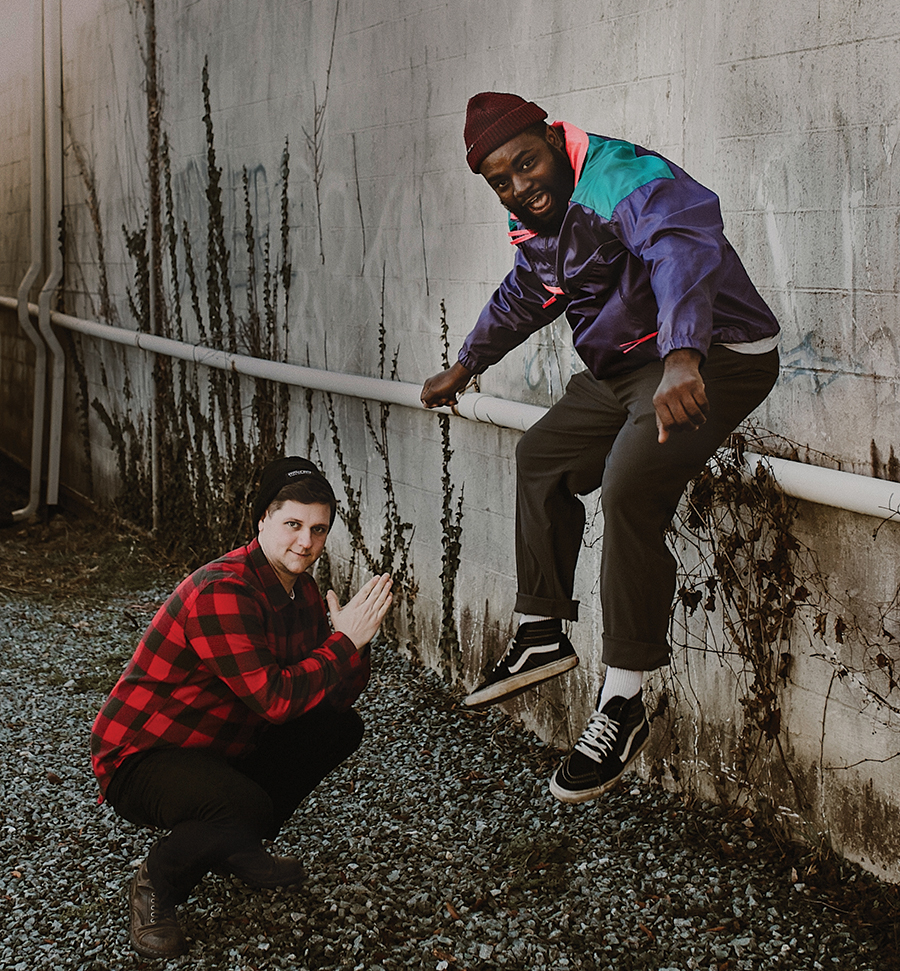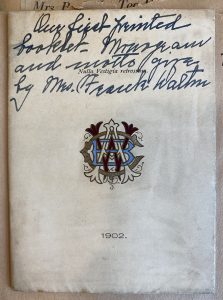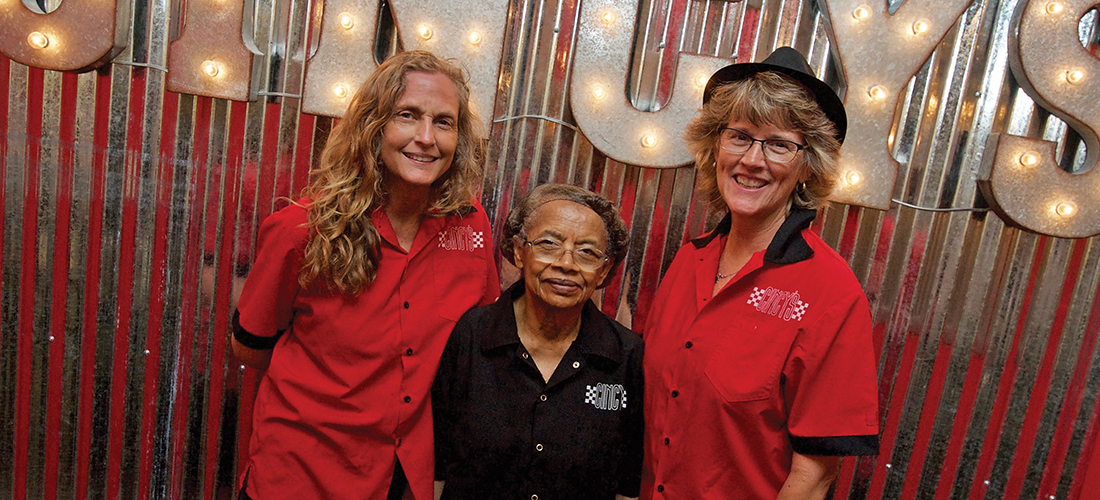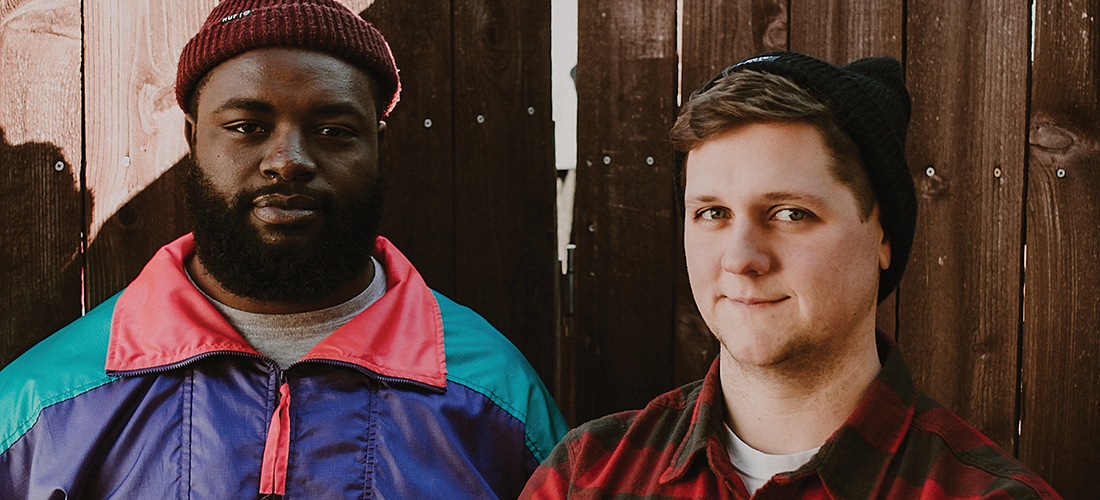Deep Dish
Free Pizza, a Greensboro podcast that celebrates up-and-coming creatives, bites into its third year
By Maria Johnson
Welcome to the Free Pizza studio.
Actually, it’s a sunroom on the back of a 1948 rental house that has sheltered roughly 1,948 students and others who orbit in the gravitational field of UNCG.
That’s an exaggeration, of course.
Two thousand people have not lived here.
It just looks like it.
But back to the studio, which is adorned with — among other things — strings of bistro lights, anime posters, a photo of the Washington Monument, speakers, a turntable, a guitar, chess pieces, an empty water bottle, a container of ibuprofen, and a covey of furniture thrifted from yard sales and estate auctions.
One of the finer pieces, a marshmallow of a black recliner in the corner, absorbs the frame of Kenrick Jobe, an affable 23-year-old portrait painter who grew up in Lexington, graduated from ECU and now lives in Durham.
A few feet and a couple of microphones away, on another puffy recliner, perches his interviewer, Daniel White, an effusive fellow who wears a wide smile, beard and watch cap as a seemingly inseparable unit. He consults an extra large iPad that’s propped in front of him on someone’s grandmother’s side table, complete with water rings.
“You guys ready?” says Jacob Beeson, whose back is turned to the duo. He’s earplugged to a laptop that’s running an audio recording app.
Nods and yeps all around.
“Today, we have the wonderful Kenrick here,” says White. “You are an amazing painter and graphic designer . . .”
Thus begins another episode of Free Pizza, a weekly podcast featuring interviews with artists you’ve probably never heard of.
Podcasts, for the untuned, are basically radio shows on the internet.
They cover scads of topics including politics, art, science, travel and all manner of exotica. Some podcasts spring from slick studios affiliated with major media outlets, like NPR. Others — most, in fact — come from grassroots creators who record in basements, garages and, ta-da, sunrooms.
Worldwide, more than half a million podcasts are zipping around the cybersphere. According to a recent survey, in this country alone, an estimated 44 percent of people older than 12 have listened to a podcast.
Which brings us back to Greensboro’s own Daniel White and Jacob Beeson, who are 28 and 26 respectively. This month, they celebrate, with a smidgeon of surprise, Free Pizza’s second anniversary.
“Obviously, we were hoping for the best, but I definitely didn’t think we’d still be going with this much momentum and steam,” says Beeson. “We’ve been overwhelmed by support.”
Listeners tap into the show on several platforms. Earlier this year, Free Pizza started uploading episodes onto Spotify, a major audio streaming service. Apple iTunes and SoundCloud also distribute the show, and there’s always the show’s website, freepizzapodcast.com.
All told, Free Pizza gets 100 to 300 downloads per episode from all sources combined, according to Beeson. Since they started, they’ve racked up north of 20,000 downloads on about 80 episodes.
Their traffic resembles that of other locally produced podcasts, including the city government’s Gate City Chatter, which is recorded in a community podcasting studio in the Greensboro Cultural Center, and a podcast called The Open Micers, which is run by comedians J.D. Etheridge and Micah Hanner.

Another area podcast, Name Redacted, is recorded in Colfax and leans toward comics and gaming. Alexander Folmar, who created Name Redacted with his friend Chris Nielsen six years ago, says Free Pizza fills a niche — showcasing grassroots artists — with easy style.
“Those dudes crush, and the reason they crush is Daniel has been a Greensboro staple for so long. He’s so personable, and his personality is not over-the-top. He does a really, really good job of asking the question and stepping away,” says Folmar.
Nielsen concurs: “In terms of local artists and creatives, they really have their finger on the beat like nobody else.”
All of this because of cars and music — with a 21st-century twist.
In the late aughts, White and Beeson, both from High Point, were teenagers swimming in the hardcore punk music scene around Greensboro. Beeson played bass in a band called Barrow. White was a fan and budding photographer who snapped pics at concerts. They had lots of mutual friends and contacts on social media.
Then, around 2011, White, who graduated with a degree in information systems at UNCG, was cruising Facebook for a job, and Beeson — who’d dallied in business studies at High Point University and Gardner-Webb University before surrendering to music — responded that there were vacancies at CarMax, where he worked. White jumped on board as a photographer for the used-car dealer, and a friendship was born.
Both guys were big fans of podcasts, then in their infancy. White was hooked on No Jumper, a Los Angeles–based program heavy on underground rappers. Jacob was tuned into Serial, an early NPR podcast. A few DIYers were streaming around Greensboro.
White and Beeson were drawn by the close-to-the-ground nature of the medium.
“I wanted to do that here, with artists and people who were not super on-the-radar,” says White. “It’s mind-blowing how many artists are around here.”
He was determined to avoid musicians because he felt they had enough exposure in zines, or small special-interest magazines.
“I think his first text said, ‘I want to do a podcast for everybody but musicians,’” Beeson remembers. “He was like, ‘How many podcasts have you ever seen where they interview painters?’”
Beeson — a sound geek who already had most of the recording equipment they would need — would be the audio engineer.
White would do most of the interviewing. He wanted to catch creatives early in their careers before their struggles and mistakes faded from memory. He wanted other artists to take heart and know that they weren’t alone.
Beeson was in. They would record several episodes on the weekends, and they would post one interview — lasting an average 30 to 45 minutes — every week.
They had no journalistic experience — they’d been interviewed by small publications about their photography and music, but that was it — so they prepared by listening to podcasts and by sharing links and notes on their phones.
They dissected interviews, figuring out how to ask questions so the session flowed naturally, as a conversation rather than an inquisition.
White came up with the name Free Pizza because . . . who isn’t attracted by free pizza? Not that they would serve free pizza because, hey, no money. But still, it had a nice ring.
After three months of preparation, Beeson opened a recording app, Apple’s Logic Pro X, on his laptop, and White sat across from his subjects, pen and pad in hand.
“I was terrified,” says White.
“The first episodes were pretty bad,” says Beeson laughing. “It was mostly us interviewing our friends. It’s the easiest thing to do when you have no credentials.”
They invited interviewees to the basement of the home where Beeson was living at the time.
“It was kinda sketchy,” admits Beeson. “It was a little damp, very cold, overwhelming concrete.”
Their first guest was their friend Savannah Patterson, an illustrator and graphic designer from Greensboro.
Another early interview: Winston-Salem videographer Justin Reich, who has worked with musicians including Ozzy Osbourne and Zakk Wylde.
Beeson was shocked by how quickly people agreed to be interviewed. He and White started reaching out to artists who lived beyond the Triad; if their audience could be anywhere, via the internet, so could their subjects.
Example: a May 2018 interview with Jessamyn Stanley, a Durham yoga instructor who has been featured in Forbes and People magazines and on BuzzFeed.
“Her story touched me on an emotional level,” says White.
At first, episodes of Free Pizza appeared only as a tab on Amplifier, a now defunct Greensboro arts and entertainment website. Free Pizza had no website of its own. But White and Beeson had lots of friends who told other friends, on social media, about Free Pizza.
A year into the project, the podcast caught the ear of Jeremy Hyler, creative director at PhotoBiz and its sister firm Zibster, website design companies in Greensboro.
Hyler was intrigued by the show’s emphasis on up-and-coming artists. Growing up in Eden, N.C., Hyler had felt the isolation of being a creative kid who knew very few kindred spirits. Free Pizza was full of those souls.
“Their stories really captured me,” he says. “We’re all kind of cut from the same fabric.”
Hyler offered White and Beeson a sponsorship agreement — a website in exchange for shout-outs during the interviews. Every couple of months, the trio huddles to map out their next steps. They’re talking about adding video and other website content for a nominal fee.
White and Beeson plan other activities for the coming year. They hope to dish up real free pizza — as in slices — at a public party and podcast with a new partner, Greensboro’s Center for Visual Artists, a nonprofit gallery that also focuses on emerging artists.
Half of Free Pizza’s subjects live in the Greensboro area, and three-quarters call North Carolina home, but the duo plan to keep expanding their geographic reach. Last year, they interviewed people — whom they knew personally or through Instagram — in Scotland and England.
“I think it’s important to know what’s going on in other places,” says White.
They also plan a road trip, maybe to Wilmington. Last spring, they did a three-day swing through Winston-Salem and the Triangle. They recorded almost 20 episodes, enough to last several months.
The pair haven’t quit their day jobs yet — White still works at CarMax, though he’s moved into doing appraisals, and Beeson works at an insurance company in Burlington.
They cling to their own creative dreams: White nurtures his photography business (www.danielwhitephoto.com) and Beeson refines his audio skills.
“Please hire me to make your record,” he says unabashedly to the universe.
Meanwhile, they’ll serve Free Pizza as long as they’re able. Financially, there’s no incentive — not yet, anyway.
“I don’t think either one of us has even gotten a dollar from it,” says Beeson.
“It’s a passion,” says White. “That’s what you see here.”
Back in the studio/sunroom, White prompts Jobe to share his story — how he started calling himself an artist at age 17 because a career aptitude test said that’s what he was; how he began by doing portraits of TV personalities like Miley Cyrus and Raven Symoné; how he carries a sketchbook and pencil at all times, but he paints in a program called Procreate on his iPad Pro; how his parents worry about him putting his work on Instagram where people could rip it off (“I’m like, ‘Mom and Dad, I gotta get it out there.’”); and how his Instagram account, @KenrickJobe, is probably his biggest marketing tool. Among his followers: Actor Caleb McLaughlin of the Netflix series Stranger Things.
“I know if the right person sees it, that’s all it takes,” says Jobe. “I just want to be able to do this for a living while providing for a family. If I’ve done that, I’ve made it, in my opinion.”
“I feel like so many people are just one break away,” says White.
Maria Johnson is a contributing editor of O.Henry. She can be reached at ohenrymaria@gmail.com





